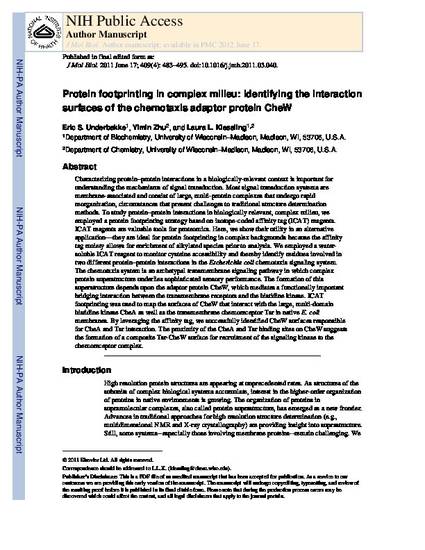
Article
Protein Footprinting in a Complex Milieu: Identifying the Interaction Surfaces of the Chemotaxis Adaptor Protein CheW
Journal of Molecular Biology
(2011)
Abstract
Characterizing protein–protein interactions in a biologically-relevant context is important for
understanding the mechanisms of signal transduction. Most signal transduction systems are
membrane-associated and consist of large, multi-protein complexes that undergo rapid
reorganization, circumstances that present challenges to traditional structure determination
methods. To study protein–protein interactions in biologically relevant, complex milieu, we
employed a protein footprinting strategy based on isotope-coded affinity tag (ICAT) reagents.
ICAT reagents are valuable tools for proteomics. Here, we show their utility in an alternative
application—they are ideal for protein footprinting in complex backgrounds because the affinity
tag moiety allows for enrichment of alkylated species prior to analysis. We employed a watersoluble
ICAT reagent to monitor cysteine accessibility and thereby identify residues involved in
two different protein–protein interactions in the Escherichia coli chemotaxis signaling system.
The chemotaxis system is an archetypal transmembrane signaling pathway in which complex
protein superstructure underlies sophisticated sensory performance. The formation of this
superstructure depends upon the adaptor protein CheW, which mediates a functionally important
bridging interaction between the transmembrane receptors and the histidine kinase. ICAT
footprinting was used to map the surfaces of CheW that interact with the large, multi-domain
histidine kinase CheA as well as the transmembrane chemoreceptor Tsr in native E. coli
membranes. By leveraging the affinity tag, we successfully identified CheW surfaces responsible
for CheA and Tsr interaction. The proximity of the CheA and Tsr binding sites on CheW suggests
the formation of a composite Tsr-CheW surface for recruitment of the signaling kinase to the
chemoreceptor complex.
Disciplines
Publication Date
June 17, 2011
DOI
10.1016/j.jmb.2011.03.040
Publisher Statement
Copyright © 2011 Elsevier B.V.
Citation Information
Eric S. Underbakke, Yimin Zhu and Laura L. Kiessling. "Protein Footprinting in a Complex Milieu: Identifying the Interaction Surfaces of the Chemotaxis Adaptor Protein CheW" Journal of Molecular Biology Vol. 409 Iss. 4 (2011) p. 483 - 495 Available at: http://works.bepress.com/eric-underbakke/6/
Creative Commons license

This work is licensed under a Creative Commons CC_BY-NC-ND International License.
